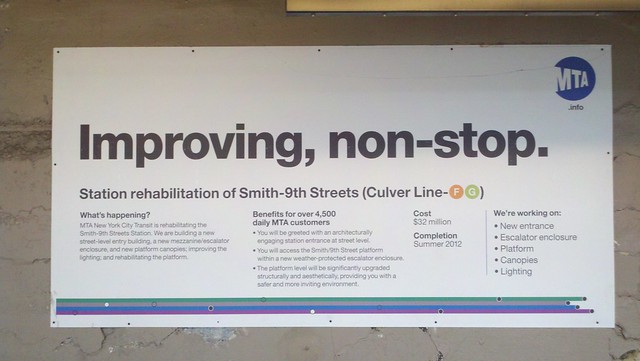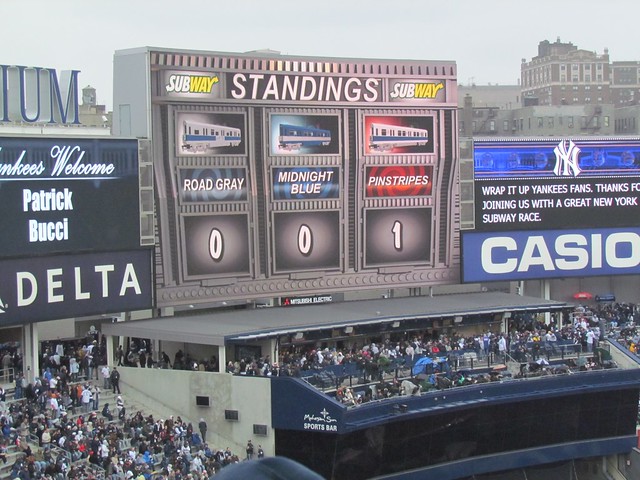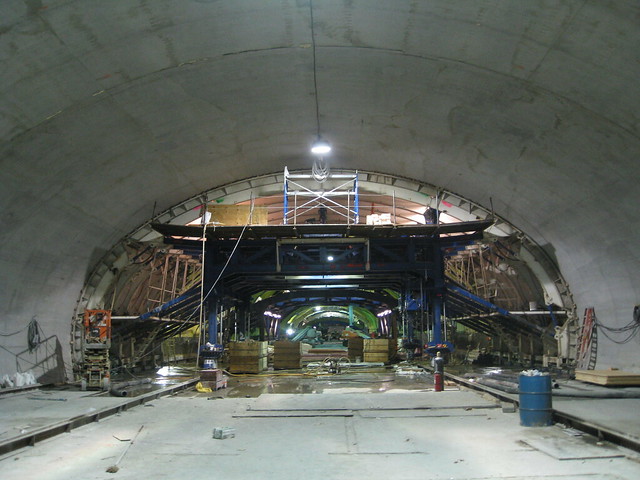
Signs as clear and as informative as this one are rare throughout the subway system. (Photo by Benjamin Kabak)
The MTA has long had a tough relationship with signs. It has struggled over the years to present Weekend Service Changes in a graphically-pleasing yet easy-to-read format, and it recently rebranded its house ads to better promote system-wide improvements. Now, its signage is again coming under question as construction sites around the city remain shrouded in mystery.
The problem is one of explication and explanation. At too many sites around the city, the MTA doesn’t adequately explain what work they’re doing, how long construction will last and what the final outcome will be. Signs are often haphazardly hung in odd places and feature long-gone completion dates with no nod to reality. In fact, signs I noticed this week at the 7th Ave. stop in Midtown claim that work is being done to improve service along the E/V route. The V, of course, hasn’t run since last June.
Andrew Grossman, the Wall Street Journal’s transit writer, tackled the issue of signs earlier this week. He writes:
Tunneling for the first phase of the Second Avenue subway will be finished by summer. Or possibly next spring. Much of the 96th Street subway station being built along the line will wrap up this summer, too. Or maybe winter 2013.
That’s the conflicting guidance on signs posted along the massive construction zone on Manhattan’s East Side. And confusing as they may be, they offer more details than riders and pedestrians get at many other Metropolitan Transportation Authority projects…
The MTA has made efforts to improve its subway communication. Last year, the agency started using a new system of clearer, centrally located signs listing service changes. Sometimes, when staircases are closed, paper signs tell people why they’re closed and when they’ll reopen. New screens revealing the wait for an approaching train got high marks when the authority surveyed riders last year.
The authority is starting to post some newly designed construction signs that are “uniform and provide consistent information,” MTA spokesman Kevin Ortiz said on Tuesday. On projects funded with federal stimulus money, the agency displays signs noting the federal government’s role—though some completion dates are no longer accurate. And it also requires contractors to post notices when station stairways and entrances are closed.
Of course, problems creep up when weeks fly by. Elevators are often shuttered long past the dates promised on the signs, and those who have worked with the MTA recognize the challenge. “I think for these big agencies, they’ve got a lot on their plate—to their credit perhaps,” David Gibson, a one-time MTA consultant on signage, said. “You can get very involved in the perspective of the project people, the construction people, and you kind of forget that this is all about customers. It takes a rigorous concern for customers to get this stuff right.”
The customers — those folks who need the system to work — are often left in the dark. “It seems like it’s never-ending,” a woman attempting to navigate Fulton Street said to The Journal. “They should post some signs somewhere…the extent of it and how long, so people don’t wonder.”
Ultimately, as Gibson notes, this is about the passenger, and it’s about communicating effectively with the passenger. Historically, the MTA has struggled to do that. It’s true that the system is vast and construction projects often do not wrap when promised. But as capital work continues, the MTA should make sure those who have only a passing interest in what goes on underground and care more about getting from Point A to Point B are well informed. It is, after all, all about the customer.

 Over the past year, as the MTA has struggled to maintain a balanced budget, “making every dollar count” has emerged as the authority’s mantra. Since finding itself on the wrong end of a budget crisis, the authority has identified over $500 million in annual savings and, amidst repeated cries for a forensic audit, has identified nearly $200 million more in savings with the potential to save on labor costs as well. But since the state comptroller can’t seem to figure out how to drill down on the MTA’s finances quickly, we have no way of knowing what the MTA should target and if their cuts are efficient.
Over the past year, as the MTA has struggled to maintain a balanced budget, “making every dollar count” has emerged as the authority’s mantra. Since finding itself on the wrong end of a budget crisis, the authority has identified over $500 million in annual savings and, amidst repeated cries for a forensic audit, has identified nearly $200 million more in savings with the potential to save on labor costs as well. But since the state comptroller can’t seem to figure out how to drill down on the MTA’s finances quickly, we have no way of knowing what the MTA should target and if their cuts are efficient. 



 The MTA has frequently come under fire for its real estate holdings. Politicians and advocates believe that the authority doesn’t make proper use of the space it both rents and owns, and underground, commercial opportunities are decidedly low rent. It is a problem the MTA is trying to solve in order to generate more money.
The MTA has frequently come under fire for its real estate holdings. Politicians and advocates believe that the authority doesn’t make proper use of the space it both rents and owns, and underground, commercial opportunities are decidedly low rent. It is a problem the MTA is trying to solve in order to generate more money. 